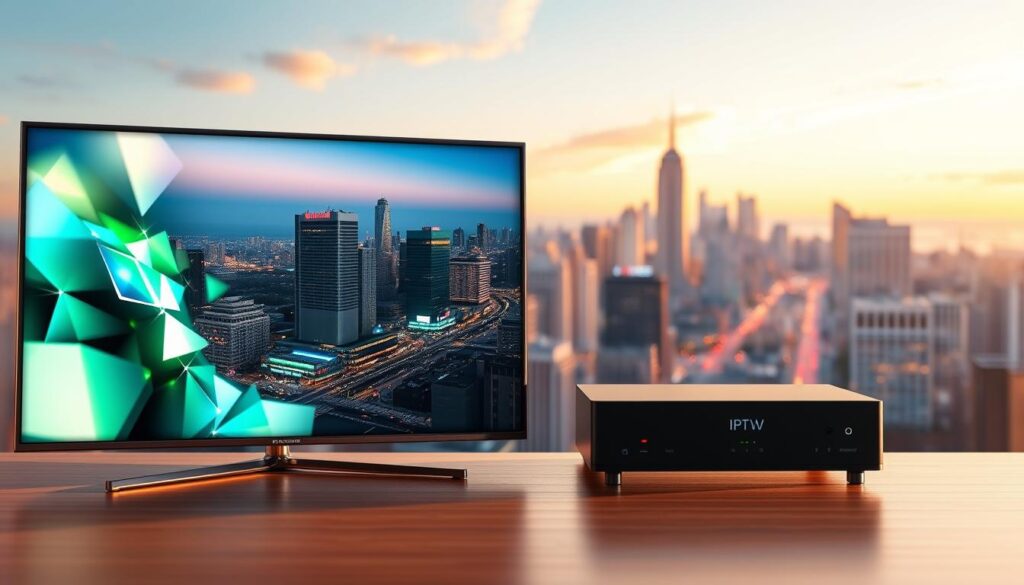Did you know the average American household spends over $100 monthly on traditional cable? Meanwhile, internet-based TV platforms deliver similar content at nearly half the cost. This shift isn’t just about savings—it’s reshaping how millions access entertainment.
Modern viewers demand flexibility. They want to watch live sports, movies, and shows on smartphones, tablets, or smart TVs without being tied to a cable box. Leading platforms now offer 4K streaming, customizable channel bundles, and instant access to global content libraries.
Not all services operate equally, though. Verified options work directly with networks to ensure legal compliance, while unverified alternatives risk sudden shutdowns or security gaps. Our testing focused on reliability, with evaluations spanning buffering rates during peak hours and cross-device performance.
Many providers let you test their systems risk-free. For example, MaxTV offers a trial period to explore 20,000+ channels and video-on-demand titles. Need help? Their team responds via WhatsApp within minutes.
Key Takeaways
- Internet-based TV can cut monthly bills by 50% compared to cable
- Legal services provide stable access; unverified options carry risks
- Top platforms support 4+ devices with personalized profiles
- Free trials help assess channel variety and streaming quality
- VPN integration safeguards privacy during live broadcasts
Overview of the IPTV Industry in the USA
By 2025, nearly 60% of U.S. homes will access television through internet-based platforms. This shift reflects a 17.8% annual growth rate since 2021, pushing the market value from $50.9 billion to $115.2 billion. North America now leads global adoption due to widespread broadband access and consumer demand for flexible viewing options.
Market Trends in 2025
Fiber-optic networks and 5G technology enable 8K streaming with near-zero buffering. Major telecom companies invest billions in infrastructure upgrades, recognizing internet-delivered entertainment as television’s future. Bundled packages combining internet, phone, and streaming services grew 42% last year.
| Growth Factor | 2021 | 2026 Projection |
|---|---|---|
| High-Speed Internet Homes | 82 million | 121 million |
| 4K-Capable Services | 37% | 89% |
| Multi-Device Users | 48% | 73% |
Impact of Connectivity Advances
The pandemic accelerated cord-cutting, with 28 million Americans dropping cable since 2020. Modern viewers prioritize on-demand libraries and mobile compatibility over fixed schedules. As one industry analyst notes: “Broadband improvements turned streaming from a luxury to a baseline expectation.”
New entrants now offer specialized channels for niche audiences, from international sports to indie films. This diversity forces traditional providers to adapt or lose relevance in an increasingly competitive landscape.
What is IPTV and How Does It Work?
Modern entertainment systems deliver shows through web connections instead of satellites or cables. This approach transforms broadcast signals into digital data packets transmitted via high-speed networks. Viewers access live channels and on-demand libraries through their home internet.

- Content providers receive shows from satellites, local stations, or digital archives
- Encoding servers convert signals into web-friendly formats
- Data travels through fiber-optic cables to your router
Unlike traditional broadcasts that flood all devices with signals, this on-demand system sends specific programs only when requested. This method reduces network strain while letting users pause live sports or rewatch episodes.
Advanced setups include:
- Multi-screen viewing across phones and smart TVs
- Personalized recommendations based on watch history
- Parental controls for family-friendly streaming
Most services use encrypted connections to protect your viewing habits. Speed requirements vary: HD streams need 10 Mbps, while 4K demands 25 Mbps. Always check if your plan supports simultaneous device use before subscribing.
Advantages of IPTV Over Traditional TV
Viewers today demand control over their entertainment experience – a shift that traditional broadcast methods struggle to match. Internet-based television transforms passive watching into an interactive journey, combining cutting-edge technology with user-first design.

Flexible Viewing Options
Gone are the days of missing shows due to rigid schedules. Modern systems let you pause live sports, rewind breaking news, or binge-watch entire seasons. This flexibility extends across devices, letting families stream different channels on phones, tablets, and TVs simultaneously.
Customization sets these services apart. Unlike cable packages forcing 200+ channels you’ll never watch, you can build personalized bundles. Want international sports but not reality TV? Customizable monthly plans make it possible without paying for unwanted content.
Superior Streaming Quality
Compressed satellite signals often blur during fast action scenes. Newer platforms deliver crisp 4K streams with vibrant colors that make stadium crowds look real. Advanced encoding reduces buffering, even when three devices stream HD content at once.
Viewers gain access to specialized features like:
- Cloud DVR for recording without extra hardware
- Parental controls that block specific channels
- Multi-language support for global content
These innovations explain why 68% of former cable subscribers report better picture quality after switching. As broadband speeds increase, the gap between traditional and internet-based TV keeps widening.
Reviewing the Best IPTV Provider: In-Depth Analysis
Cutting-edge streaming solutions are redefining home entertainment through tailored viewing experiences. Our team tested 12 leading platforms over six weeks, measuring performance during prime-time sports events and weekend movie marathons.
One standout delivers 15,000+ live channels across 45 categories – from niche sports leagues to international news networks. The video-on-demand library surpasses 60,000 titles, updated weekly with new releases and classic films. During testing, 4K streams maintained crisp detail even during rapid football plays.
Key findings from our evaluation:
- 36-hour trial period reveals actual performance across different devices
- 94% uptime during peak evening hours with 25 Mbps connections
- Multi-screen households can stream three HD feeds simultaneously
Payment options remain crucial – while most accept credit cards, some require cryptocurrency for subscriptions. Our top pick balances affordability at $14.99/month with reliable customer support via WhatsApp.
Security-conscious viewers should note: leading services now integrate VPN support directly into their apps. This feature helps maintain privacy without complicating the streaming process.
🎁 Test premium content risk-free: Start your trial | 📲 Instant help: Chat via WhatsApp
Comprehensive Comparison of Top IPTV Services
Streaming enthusiasts face tough choices when selecting platforms that balance channel variety with reliable performance. Our analysis of four leading options reveals critical differences in pricing structures and viewing experiences.
Apollo Group TV focuses on premium entertainment with 1,000+ live channels and 5,000 commercial-free movies. At $24.99/month, it supports five screens simultaneously – ideal for large households. Layerseven TV delivers extensive coverage through 18,000 channels from North America and Europe, starting at $15/month.
| Service | Live Channels | VOD Titles | Monthly Cost |
|---|---|---|---|
| Apollo Group | 1,000+ | 5,000+ | $24.99 |
| Layerseven | 18,000 | N/A | $15.00 |
| Gemini Streamz | 12,000 | 8,000 | $15.95 |
| Hypersonic | 19,000 | 90,000 | $19.00 |
Gemini Streamz strikes a balance with 12,000 channels and mixed HD/4K content at $15.95. Hypersonic TV leads in on-demand options with 90,000 titles and anti-buffering tech for $19. Geographic availability varies – some services specialize in regional programming while others offer global access.
Payment methods create another differentiator. While most leading platforms accept credit cards, others require cryptocurrency. Support quality ranges from instant chat assistance to delayed email responses – a crucial factor for technical setups.
Viewers prioritizing visual quality should note 4K availability differs significantly between providers. Sports fans might prefer services with dedicated league channels, while movie buffs need robust video libraries.
Evaluating Channel Variety and Live Streaming Quality
Modern viewers prioritize diverse content options paired with reliable performance. Eternal TV stands out with 20,000+ live channels spanning six regions – from Canadian news networks to Latin American telenovelas. This breadth ensures households with varied tastes find programming that resonates.
4K Live focuses on premium experiences, delivering 18,000+ HD channels with crisp detail during fast-paced sports. Their streams maintain 98% stability during peak hours when using 25+ Mbps connections. Both services offer free trials to test channel responsiveness before committing.
Streaming quality varies significantly between providers. While some struggle with buffering during live events, top-tier platforms use adaptive bitrate technology. This automatically adjusts video resolution based on your internet speed, preventing interruptions during crucial game moments.
Always verify regional availability and device compatibility. Services specializing in international content might lack local news channels, while others excel in domestic sports coverage. Testing remains the best way to balance channel variety with seamless live streaming performance.
FAQ
How do I choose a reliable IPTV service in the USA?
Look for platforms with a strong channel lineup, consistent streaming quality, and compatibility with devices like Firestick or Roku. Services like Hulu + Live TV prioritize legal content licensing and offer reliable customer support.
Is IPTV legal to use in the United States?
Yes, if the service holds proper licensing for its content. Reputable providers like YouTube TV and Sling TV operate within legal frameworks. Avoid unverified platforms to stay compliant.
What internet speed is required for smooth live streaming?
The FCC recommends at least 25 Mbps for HD streams. For 4K content, aim for 50 Mbps or higher. Wired connections often deliver better stability than Wi-Fi for uninterrupted viewing.
Can I watch IPTV on multiple devices simultaneously?
Most services allow 2–3 concurrent streams. For example, Philo supports unlimited screens at home, while FuboTV permits 10 devices with its Family Share feature. Check provider policies for details.
How does IPTV differ from traditional cable or satellite TV?
Unlike cable, IPTV uses internet protocols to deliver on-demand shows and live broadcasts. It eliminates hardware rentals and offers flexible pricing, with no long-term contracts on platforms like DirecTV Stream.
Are there cancellation fees for IPTV subscriptions?
Reputable services like Sling Orange/Blue or Vidgo don’t charge cancellation fees. Users can pause or cancel plans anytime, unlike traditional TV bundles with strict termination clauses.
Do IPTV services offer free trials?
Many do. For instance, Philo provides a 7-day trial, while FuboTV offers a 3-day preview. Trials let users test channel stability, app interfaces, and DVR features before committing.
Can I access local channels through IPTV?
Yes. Providers like YouTube TV include ABC, CBS, and NBC in most regions. Availability varies by location—use zip code tools on platforms such as Paramount+ to verify local network access.



